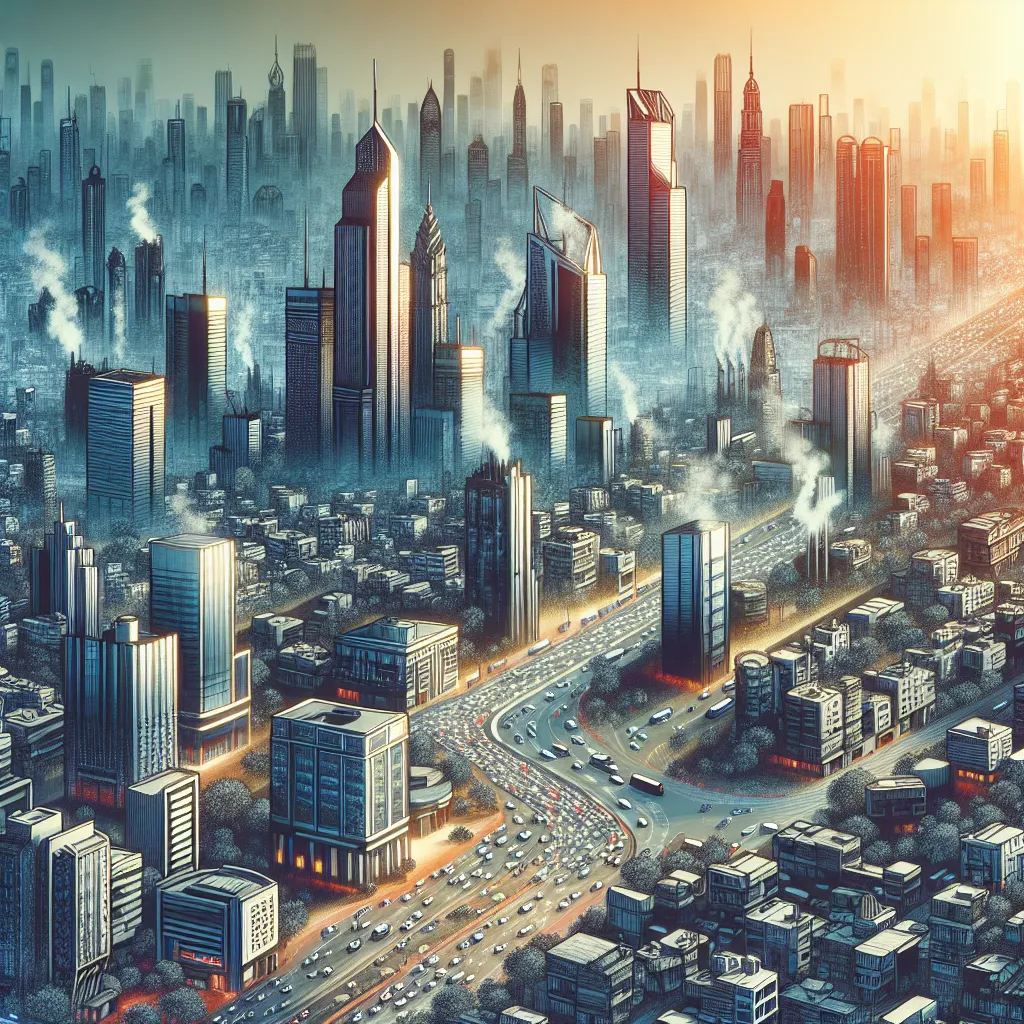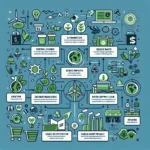Air pollution in cities is a recurring theme in IELTS Writing Task 2, appearing frequently in past exams and likely to continue as a significant topic in future tests. This environmental issue’s relevance to urban development and public health makes it a prime candidate for examination. Let’s explore some actual and potential essay questions related to this subject.
 Urban air pollution in a bustling city
Urban air pollution in a bustling city
Analysis of the Topic
The topic of reducing air pollution in cities intersects with several key areas:
- Environmental protection
- Urban planning and development
- Public health
- Transportation systems
- Industrial regulations
Given its multifaceted nature, this topic allows candidates to demonstrate their understanding of complex issues and propose solutions, making it ideal for IELTS Writing Task 2.
Sample Essay Question
Let’s focus on a question that closely resembles those found in actual IELTS exams:
Air pollution is becoming a serious problem in many cities. What are the main causes of this problem, and what measures can be taken to reduce its effects?
Question Analysis
This question consists of two parts:
- Identifying the main causes of air pollution in cities
- Suggesting measures to reduce the effects of air pollution
To answer this effectively, candidates should:
- Discuss at least 2-3 main causes of urban air pollution
- Propose a range of solutions addressing these causes
- Ensure a balanced approach between causes and solutions
- Use specific examples to support their arguments
Sample Essays
Band 7-8 Essay
Air pollution has emerged as a critical issue in numerous urban centers worldwide, posing significant threats to both human health and the environment. This essay will examine the primary factors contributing to this problem and propose several measures to mitigate its impact.
The main causes of air pollution in cities are multifaceted. Firstly, the exponential growth of vehicular traffic is a major contributor, with millions of cars, buses, and trucks emitting harmful pollutants such as carbon monoxide and particulate matter. Secondly, industrial activities, particularly those involving fossil fuel combustion, release large quantities of sulfur dioxide and nitrogen oxides into the atmosphere. Lastly, the rapid pace of urbanization has led to decreased green spaces, which play a crucial role in naturally filtering air pollutants.
To address these issues, a comprehensive approach is necessary. One effective measure is the implementation of stricter emission standards for vehicles and industries. This could involve mandating the use of catalytic converters in all vehicles and requiring industries to install scrubbers in their chimneys. Additionally, promoting the use of public transportation and encouraging the adoption of electric vehicles can significantly reduce vehicular emissions. Cities could invest in extensive public transport networks and offer incentives for electric vehicle ownership.
Furthermore, urban planning should prioritize the creation and preservation of green spaces. Planting trees and developing parks not only helps absorb pollutants but also improves the overall quality of urban life. Lastly, raising public awareness about the dangers of air pollution and promoting individual responsibility can lead to behavioral changes that contribute to cleaner air, such as reducing energy consumption and choosing eco-friendly products.
In conclusion, while the causes of urban air pollution are complex, there are numerous strategies available to combat this issue. By implementing a combination of regulatory measures, infrastructure improvements, and public education initiatives, cities can make significant strides in reducing air pollution and creating healthier environments for their residents.
(Word count: 309)
Band 6-7 Essay
Air pollution is becoming a big problem in many cities around the world. This essay will look at the main reasons for this issue and suggest some ways to solve it.
One of the biggest causes of air pollution in cities is the large number of cars and other vehicles on the roads. As more people buy cars, the amount of exhaust fumes in the air increases. Another important cause is factories and power plants that burn fossil fuels like coal and oil. These industries release harmful chemicals into the air. Lastly, the cutting down of trees and green spaces in cities means there are fewer natural ways to clean the air.
To reduce air pollution, there are several things that can be done. First, governments should make stricter rules about car emissions and encourage people to use public transport more. This could include making bus and train services better and cheaper. Second, industries should be required to use cleaner technologies that produce less pollution. This might mean using filters on factory chimneys or switching to renewable energy sources like solar or wind power.
Another important step is to plant more trees and create more parks in cities. Trees help to clean the air naturally and also make cities look nicer. Finally, it’s important to educate people about air pollution and what they can do to help, like using less electricity at home or choosing products that are better for the environment.
In conclusion, air pollution in cities is caused by things like too many cars, polluting industries, and lack of green spaces. By taking steps like improving public transport, making industries cleaner, planting more trees, and educating people, we can help to reduce this problem and make our cities healthier places to live.
(Word count: 292)
Writing Tips
When addressing this topic, consider the following:
-
Vocabulary: Use a range of environmental and urban planning terminology. For higher bands (7-8), incorporate more sophisticated vocabulary such as “mitigate,” “urbanization,” and “particulate matter.” For bands 6-7, use simpler terms like “reduce,” “city growth,” and “air particles.”
-
Grammar:
- For bands 7-8: Utilize complex sentence structures, such as “While the causes of urban air pollution are multifaceted, the solutions require a comprehensive approach involving both governmental and individual actions.”
- For bands 6-7: Use a mix of simple and compound sentences, like “Air pollution is caused by many things. One big cause is the large number of cars in cities.”
-
Coherence and Cohesion: Ensure a logical flow of ideas. Use linking words appropriately to connect your points.
-
Task Response: Address all parts of the question. For this topic, discuss both causes and solutions with equal emphasis.
-
Examples: Include specific examples to support your points, such as mentioning particular cities known for their successful pollution reduction strategies.
Key Vocabulary
-
Air pollution (noun) /eə pəˈluːʃən/ – The presence of harmful substances in the air.
-
Emissions (noun) /ɪˈmɪʃənz/ – The production and discharge of something, especially gas or radiation.
-
Particulate matter (noun) /pɑːˈtɪkjʊlət ˈmætə(r)/ – Tiny particles of solid or liquid suspended in a gas or liquid.
-
Urbanization (noun) /ˌɜːbənaɪˈzeɪʃən/ – The process of making an area more urban.
-
Sustainable (adjective) /səˈsteɪnəbl/ – Able to be maintained at a certain rate or level.
-
Mitigation (noun) /ˌmɪtɪˈɡeɪʃən/ – The action of reducing the severity, seriousness, or painfulness of something.
-
Eco-friendly (adjective) /ˌiːkəʊ ˈfrendli/ – Not harmful to the environment.
-
Renewable energy (noun) /rɪˈnjuːəbl ˈenədʒi/ – Energy from a source that is not depleted when used.
Conclusion
The topic of reducing air pollution in cities is likely to remain relevant in IELTS Writing Task 2. To prepare effectively, practice writing essays on related themes such as:
- The role of individual actions in combating urban air pollution
- Balancing economic growth with environmental protection in cities
- The impact of air pollution on public health and quality of life
- Comparing air pollution management strategies in developed and developing countries
By familiarizing yourself with these aspects and practicing your essay writing skills, you’ll be well-prepared to tackle any question on this topic in your IELTS exam.
For more information on related environmental topics, you might find these articles helpful:
- How to Reduce Noise Pollution in Cities
- How to Create a Sustainable City
- Effects of Air Pollution on Children
Remember, tackling environmental issues in your writing demonstrates not only your language skills but also your awareness of global challenges, which can impress IELTS examiners.


